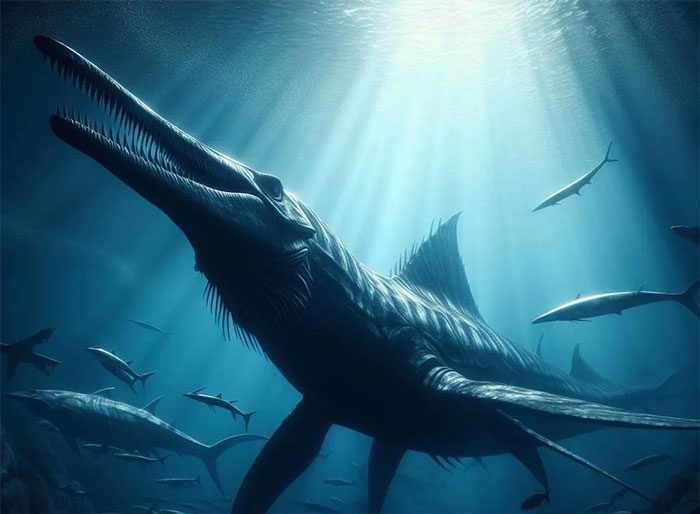Scientists Have Been “Lost” for Over 170 Years Due to the Discovery of the Strange, Giant Remains of a Mysterious Creature Near Bristol, England.
According to Sci-News, the mysterious creature was uncovered at Aust Cliff – a renowned fossil site in England – in 1850, featuring a massive cylindrical bone that led to its misidentification as a member of the titanosaurs, the largest group of dinosaurs in the world.
It wasn’t until the early 20th century that some paleontologists began to suspect it was not a dinosaur.
An initially absurd hypothesis was proposed: It could be an ichthyosaur, a type of marine reptile of incredible size!

One of the bone fragments found, embedded in the ancient seabed – (Photo: University of Bonn).
Ichthyosaurs are aquatic relatives of dinosaurs, characterized by their bizarre appearance, resembling a chaotic hybrid between dinosaurs and fish.
It seems unreasonable to say this, as most ichthyosaurs were relatively small in the realm of monsters from the Triassic – Jurassic – Cretaceous periods. Most ichthyosaurs measured only a few meters long, while even the largest members of this group reached just over 10 meters.

Ichthyosaurs are a group of creatures still shrouded in mystery – (Graphic Image).
In a new study, Professor Martin Sander and Dr. Marcello Perillo from the University of Bonn (Germany) re-examined the specimen to uncover the truth about the strange creature in England.
They utilized a special type of microscope to demonstrate that the bone structure of the creature contained unusual features.
It housed long, mineralized collagen fibers intertwined in a manner quite different from most other animal bones. However, the scientists also discovered a similarity: Another large ichthyosaur from Canada exhibited a closely resembling bone structure.
This discovery confirmed that the giant fossilized bones found in England belonged to an ichthyosaur, not to any terrestrial animal, as stated in their publication in the scientific journal PeerJ.
Geological evidence also indicated that the area where the fossil emerged 200 million years ago – the time when the creature lived, during the Triassic period – was once an ocean.
New calculations aligned with previous estimates, indicating that the creature was at least 25-30 meters long when it was alive. It likely used its pointed snout to stab at prey, similar to how modern-day sperm whales do, along with a powerful jaw to finish the job.
This suggests that the scientific community should reconsider some perspectives on this ancient group of marine monsters. According to researchers from the University of Bonn, this may not be as inexplicable as it seems.
Before this species came into existence, its ancestors had evolved around 250 million years ago. By the 200 million-year mark, most species in this group had gone extinct.
The ichthyosaurs we commonly find belong to the lineage from the Jurassic – Cretaceous periods. It is possible that during this time, ichthyosaurs evolved to be smaller, adapting to more modern environments.
Therefore, it cannot be said that their ancestors were gigantic monsters. The early Triassic period was also a time when ancestors of many other colossal creatures emerged on Earth, such as whales. The length of 25-30 meters for this ichthyosaur is still smaller than that of a blue whale.


















































